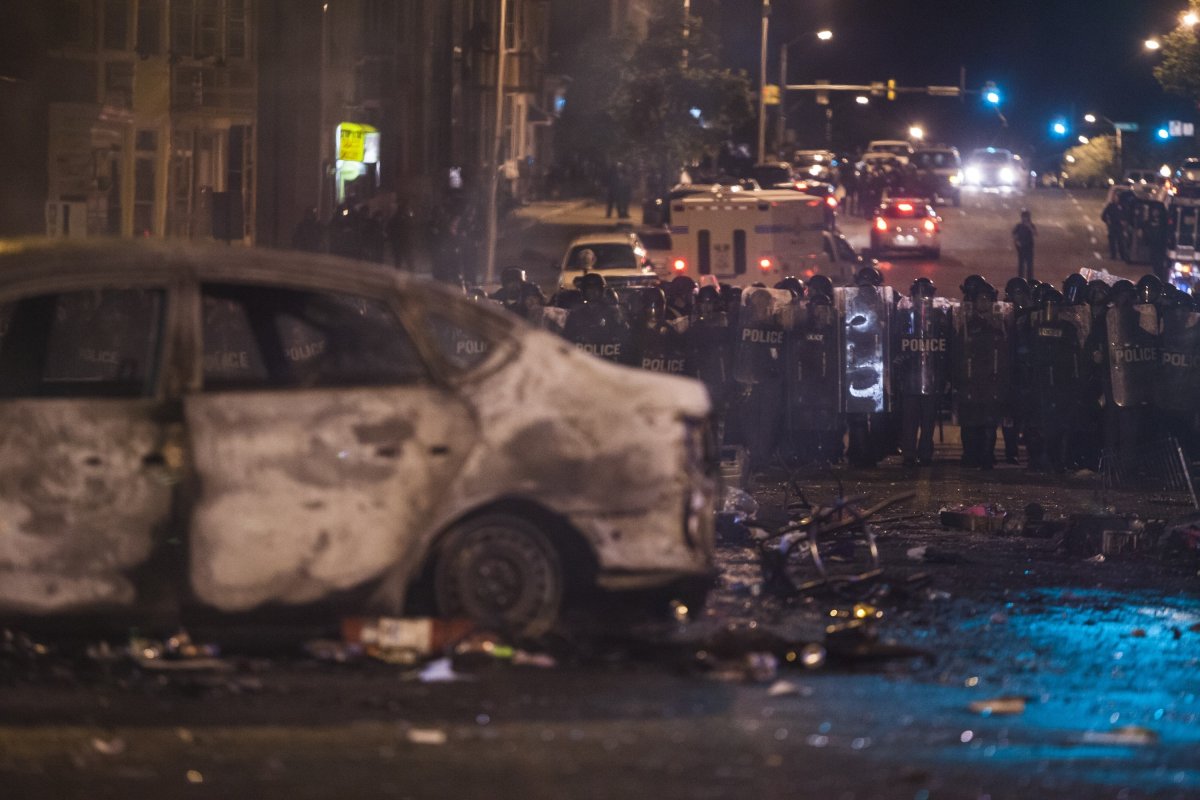Baltimore, Maryland was consumed by rioting on Monday as protesters upset by the death of Freddie Gray clashed with police, torched cars, looted stores, and burned down buildings.

While the riots broke out with protesters angered by perceived police brutality, there are still plenty of unknowns surrounding the significant injuries which led to Gray’s death a week after his arrest.
Here’s what we know.
There was a lengthy police chase outside of a public housing complex in Baltimore as four police officers tried to arrest Gray on the morning of April 12, police said.
Cell phone video from the arrest showed two police officers picking up Gray from on top of an overturned bicycle before dragging his nearly motionless body into the back of a police van. He could be heard making some noises and people off-camera yelled that it appeared his leg was broken.
WATCH: Video of Freddie Gray’s arrest shows him dragged to police vehicle
‘Spine was 80 per cent severed at his neck’
Police charge documents obtained by The Guardian offer little insight into what happened that morning and offer a less detailed and more peaceful interpretation of the arrest than that later given by Deputy Police Commissioner Kevin Davis.
The documents said police retrieved a switchblade from Gray after he was arrested “without force or incident.” Police later admitted there was a chase.
The documents did say however that Gray “suffered a medical emergency and was immediately transported to Shock Trauma via Medic.”
Deputy Commissioner Jerry Rodriguez admitted autopsy results concluded Gray suffered a “significant spinal injury that led to his death” but it’s still unclear how.
He went on to say that something must have happened between the time he was put into the van and when he arrived at the station and an ambulance was called.
“When Mr. Gray was put in that van, he could talk, he was upset. And he was taken out of that van, he could not talk and he could not breathe,” Rodriguez said.
Officers stopped the van multiple times after arresting Gray; the first time to put his legs in irons and the second time to “deal” with him, Davis said during a press conference last week. The van stopped again to pick up another person, before finally making it to the police station where an ambulance was called.
It’s that second interaction that is currently under investigation.
Other details emerged about the ride, including the fact Gray was left without a seatbelt despite policy mandating the safety measure.
Gray slipped into a coma and died on April 19 while in hospital. Official autopsy results said he died from a spinal injury but exactly when and how Gray was injured remains a mystery.
Billy Murphy, the lawyer for the Gray family, told reporters that Freddie Gray’s spine was 80 per cent severed at his neck.
Police refused medical attention
Deputy Police Commissioner Kevin Davis said Gray should have immediately received medical attention at the time of his arrest. But he didn’t.
Police Commissioner Anthony Batts also said Gray asked for an inhaler and medical care several times during the ride but didn’t get either.
Six officers suspended
The Baltimore Police Department started an investigation shortly after Gray’s death and said results could be ready by Friday.
Six police officers were suspended with pay following Gray’s death: Lt. Brian Rice, Sgt. Alicia White, Officer William Porter, Officer Garret t Miller (whose name appears on the police documents), Officer Edward Nero, and Officer Caesar Goodson.
Five of those officers have given statements to investigators, but it’s not known which ones or what the statements said, according to The Baltimore Sun.
‘I want answers’
WATCH: (April 25)Aerial footage of Baltimore demonstration protesting death of Freddie Gray
But the investigation has done little to quell the anger of Baltimore residents and people nationwide who fear Gray’s death is the latest in a string of deaths of black men like Michael Brown or Walter Scott at the hands of police officers.
Protests had, for the most part, remained calm until Monday and Mayor Stephanie Rawlings-Blake went so far as to thank residents for peacefully protesting last week while she told reporters she wants “answers” about what happened to Gray.
Increasingly violent protests
Two people were hurt and three others arrested as violence flared up for the first time over the weekend. Baltimore erupted in the hours following Gray’s funeral on Monday.
As Gray’s funeral was set to begin Monday, Baltimore police announced that they had received a “credible threat” that once-rival gangs had teamed up to “take out” law enforcement. That threat set the stage for violent protests and looting which blanketed the city hours later.
The violent protests started Monday afternoon near the spot where Gray was arrested and by midnight had spread across the city, leaving 15 officers injured, police cars destroyed, and several stores looted.
The National Guard was eventually called in Monday to help manage the protests but not before Batts admitted it had become unmanageable.
“They just outnumbered us and outflanked us,” Batts said. “We needed to have more resources out there.”
The mayor instituted a weeklong, daily curfew beginning Tuesday from 10 p.m. to 5 a.m. and Baltimore schools remain closed the day after the riots.
-With files from the Associated Press



Comments